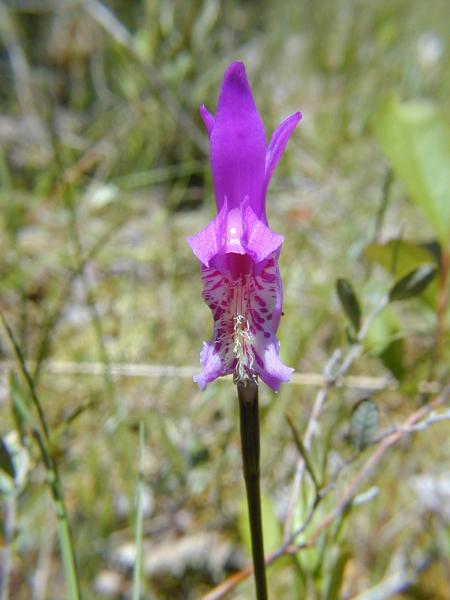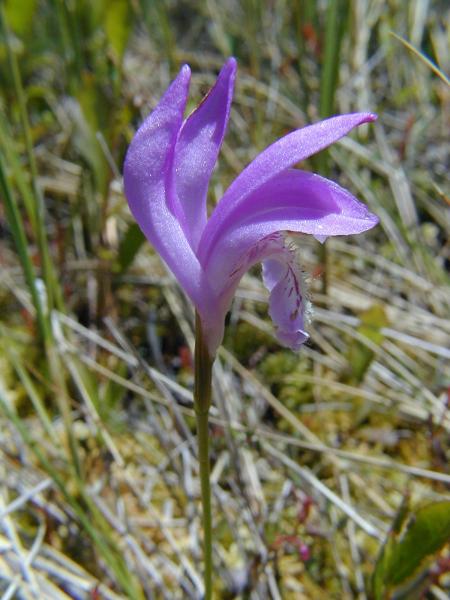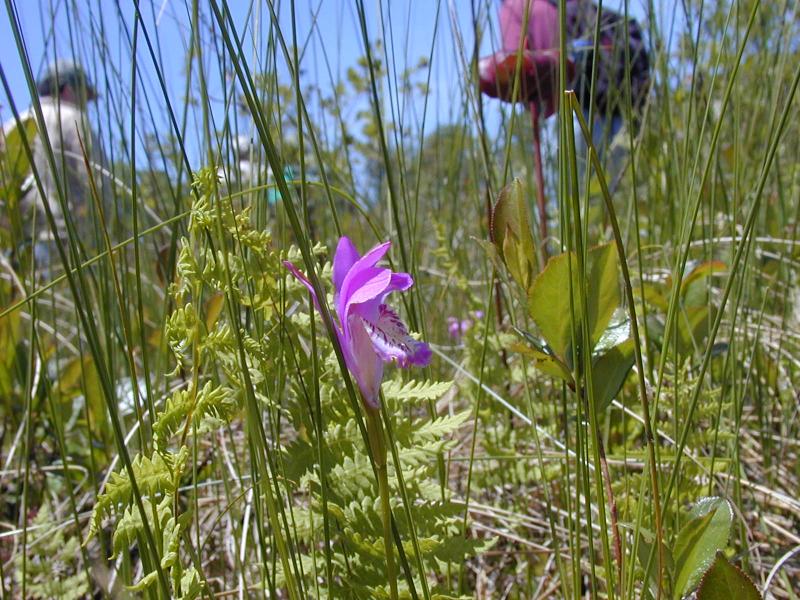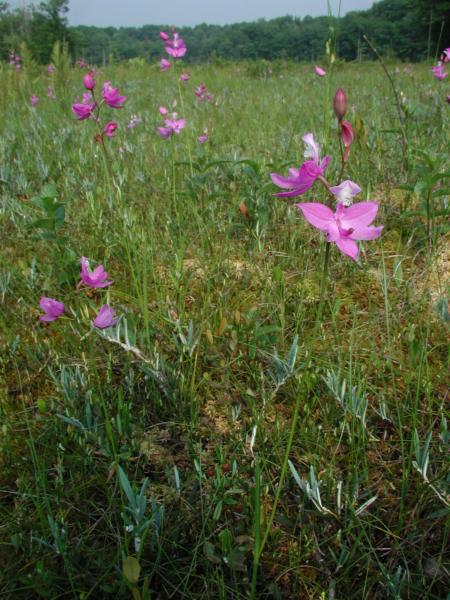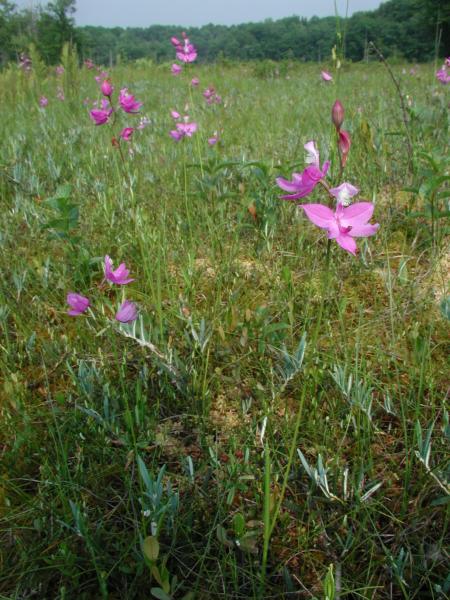Dragon's Mouth Orchid
Arethusa bulbosa L.
- Class
- Monocotyledoneae (Monocots)
- Family
- Orchidaceae (Orchid Family)
- State Protection
- Threatened
Listed as Threatened by New York State: likely to become Endangered in the foreseeable future. For animals, taking, importation, transportation, or possession is prohibited, except under license or permit. For plants, removal or damage without the consent of the landowner is prohibited.
- Federal Protection
- Not Listed
- State Conservation Status Rank
- S2
Imperiled in New York - Very vulnerable to disappearing from New York due to rarity or other factors; typically 6 to 20 populations or locations in New York, very few individuals, very restricted range, few remaining acres (or miles of stream), and/or steep declines.
- Global Conservation Status Rank
- G5
Secure globally - Common in the world; widespread and abundant (but may be rare in some parts of its range).
Summary
Did you know?
Dragon's-mouth orchid is considered rare throughout much of its range. This orchid is listed as rare in 17 of the 21 states and 6 of the 9 provinces where it is found. A number of populations are known from the northern Great Lakes. This orchid is difficult to see when it is not in bloom.
State Ranking Justification
This pink orchid, once found throughout much of the state, is currently limited to some higher quality fen and bog communities. The total number of known populations is estimated at 20. There are a number of historical populations which have not been inventoried, but most of these are believed to be extirpated. Historically, there were a number of scattered populations on Long Island, but the last time this plant was reported from Long Island was in the mid-1980s. There are probably a few scattered stems still present there, but its long-term prognosis on Long Island is grim.
Short-term Trends
While the Long Island populations have always been small, no plants have been reported on Long Island since the mid-1980s. These populations are feared lost. Populations in the Adirondacks, central New York, and St. Lawrence Valley have been relatively stable as long as succession does not shade out the orchid.
Long-term Trends
The orchid was once known from scattered locations on Long Island, in the Hudson Valley, and in the Mohawk Valley. Today, we do not know of any populations within these regions of the state. Fortunately, the populations in the Adirondacks and central New York have not declined.
Conservation and Management
Threats
Invasive plants and succession of the habitat to shrubs are a continuing threat to most of the populations present around the state. Populations on Long Island are threatened by development and natural changes in habitat. These Long Island populations are usually small with only a few plants each. As a result, even minor threats or changes to the habitat can extirpate these populations. Some upstate populations are threatened by surrounding development, but most of them are in isolated wetlands. Any hydrologic changes that impact the wetlands where this orchid is found would certainly threaten the long-term stability of the orchids in and near the impacted site.
Conservation Strategies and Management Practices
Since development activities directly result in habitat loss and indirectly may cause an increase in invasive species, sufficient buffers are needed around sites where this orchid is known to occur. These buffers should be a minimum of 100 meters. The buffers should be greater than 100 meters in cases where drainage patterns, slope, and/or soil type may result in runoff into the wetland supporting this orchid. In areas where the orchid is known, some active management to reduce the overall shrub cover may be needed to maintain an open canopy. As a precaution to limit illegal collecting and the spread of invasive species, human visitation to sites where this orchid is found should be monitored.
Research Needs
Habitat studies are needed on Long Island to determine the habitat requirements there. The Long Island populations are in vastly different habitat than typical habitat observed elsewhere in New York. In order to provide more detailed management requirements, a competition study is needed to determine the population dynamics of this orchid as a site succeeds from an open wetland to a shrub-dominated wetland. Habitat modeling may be helpful in locating new populations.
Habitat
Habitat
This is an orchid of sphagnum hummocks within rich graminoid fens and medium fens. Smaller populations are also located in wet depressions of maritime shrub thickets on the morainal bluffs near the Atlantic Ocean (New York Natural Heritage Program 1998). Sphagnum bogs and swampy meadows (Gleason and Cronquist 1991). Sphagnous bogs and peaty meadows (Fernald 1970).
Associated Ecological Communities
- Dwarf shrub bog*
(guide)
A wetland usually fed by rainwater or mineral-poor groundwater and dominated by short, evergreen shrubs and peat mosses. The surface of the peatland is usually hummocky, with shrubs more common on the hummocks and peat moss throughout. The water in the bog is usually nutrient-poor and acidic.
- Inland poor fen
(guide)
A wetland fed by acidic water from springs and seeps. Plant remains in these fens do not decompose rapidly and thus the plants in these fens usually grow on older, undecomposed plant parts of mostly sphagnum mosses.
- Maritime shrubland
(guide)
A shrubland community that occurs on dry seaside bluffs and headlands that are exposed to offshore winds and salt spray.
- Medium fen
(guide)
A wetland fed by water from springs and seeps. These waters are slightly acidic (pH values generally range from 4.5 to 6.5) and contain some dissolved minerals. Plant remains in these fens do not decompose rapidly and thus the plants in these fens usually grow on older, undecomposed plant parts of woody material, grasses, and mosses.
- Northern white cedar swamp
(guide)
A swamp that occurs on organic soils in cool, poorly drained depressions in central and northern New York, and along lakes and streams in the northern half of the state. These swamps are often spring-fed with continually saturated soils. Soils are often rich in calcium. The characteristic tree is northern white cedar, which makes up more than 30% of the canopy cover.
- Perched bog*
(guide)
A wetland that occurs in shallow depressions in rock outcrops where the water table is locally higher than expected (perched) because of an impervious soil or rock layer. The most abundant plants are peat mosses (Sphagnum) and ericaceous shrubs. The water is usually very acidic and has low amounts of dissolved minerals.
- Rich graminoid fen
(guide)
A wetland of mostly grasses usually fed by water from highly calcareous springs or seepage. These waters have high concentrations of minerals and high pH values, generally from 6.0 to 7.8. Plant remains do not decompose rapidly and these grasses usually grow on older, undecomposed plant parts.
- Rich shrub fen
(guide)
A wetland with many shrubs that is usually fed by water from springs and seeps. These waters have high concentrations of minerals and high pH values, generally from 6.0 to 7.8. Plant remains in these fens do not decompose rapidly and thus the plants in these fens usually grow on older, undecomposed woody plant parts.
* probable association but not confirmed.
Associated Species
- Andromeda glaucophylla
- Calopogon tuberosus
- Carex diandra (lesser-panicled sedge)
- Carex echinata
- Carex exilis (meager sedge)
- Carex lasiocarpa
- Carex limosa (mud sedge)
- Chamaedaphne calyculata (leatherleaf)
- Drosera intermedia (spatulate-leaved sundew)
- Drosera rotundifolia (round-leaved sundew)
- Dulichium arundinaceum
- Eriophorum tenellum (rough cotton-grass)
- Kalmia angustifolia
- Kalmia polifolia (bog laurel)
- Larix laricina (tamarack)
- Lysimachia thyrsiflora (tufted-loosestrife)
- Maianthemum canadense (Canada mayflower)
- Menyanthes trifoliata (buck-bean)
- Myrica gale (sweet gale)
- Osmunda regalis
- Picea mariana (black spruce)
- Pogonia ophioglossoides (rose pogonia)
- Rhododendron groenlandicum (Labrador-tea)
- Rhododendron viscosum (swamp azalea)
- Sarracenia purpurea (purple pitcherplant)
- Thelypteris palustris
- Trientalis borealis
- Vaccinium corymbosum (highbush blueberry)
- Vaccinium oxycoccos (small cranberry)
Range
New York State Distribution
This orchid has a scattered distribution including areas within the eastern shore of Lake Ontario, the upper Hudson River, southern and eastern Adirondacks, Hudson Valley, and eastern Long Island.
Global Distribution
Dragon's mouth orchid (Arethusa bulbosa) occurs from Newfoundland west to Minnesota and Saskatchewan, and south to Maryland, northern Indiana, and in the Appalachian Mountains to North and South Carolina. The species is disjunct in Louisiana. The distribution of Dragon's Mouth orchid is patchy throughout much of this range, especially in the south.
Identification Comments
General Description
Dragon's Mouth orchid has one, sometimes two, magenta to bluish to white flowers at the top of a single narrow stem about 6-40 centimeters tall. The lip of the flower is pinkish-white with purple splotches and a yellow midvein. It curves out then down and has fringe on the top. Three petals form a hood over the lip while the two remaining petals stick up like rabbit ears. There is one long, narrow leaf halfway up the stem that is absent when the plant is in flower.
Identifying Characteristics
Once a person has seen this lovely orchid in the field, it is difficult to forget its striking features. Growing from a bulb, each plant usually only produces a single stem. This plant is essentially leafless at flowering, with one leaf arising from the upper of 1-3 bracts after flowering. The flower lip ascends at the base then curves forward and down at the widened summit. This lip is bearded, pinkish-white in color, and usually spotted and streaked with purple and yellow. The sepals and lateral petals are erect or arched-ascending over the column. The erect capsule is 2.5-4 cm long, long beaked, and often capped by a withering, but persistent, perianth.
Best Life Stage for Proper Identification
While experts can identify this plant in fruit or even from the dried persisting fruit stalks, for easy identification it is best to search for it in flower. When flowering, this plant can be seen from a great distance if not hidden by over-topping vegetation.
Similar Species
Rose pogonia (Pogonia ophioglossoides) has well developed leaves at flowering while Arethusa is essentially leafless at the time of flowering.
Best Time to See
The peak blooming time is Memorial Day weekend for Long Island and early to mid-June for northern New York. Flowers may be observed until late June or early July. The fruiting capsules could persist for more than a year, but most are broken down by compaction from snowfall. Surveys should be conducted during the peak blooming periods.
- Flowering
- Fruiting
The time of year you would expect to find Dragon's Mouth Orchid flowering and fruiting in New York.
Dragon's Mouth Orchid Images
Images of Similar Species
Taxonomy
Dragon's Mouth Orchid
Arethusa bulbosa L.
- Kingdom Plantae
- Phylum Anthophyta
- Class Monocotyledoneae
(Monocots)
- Order Orchidales
- Family Orchidaceae (Orchid Family)
- Order Orchidales
- Class Monocotyledoneae
(Monocots)
- Phylum Anthophyta
Additional Common Names
- Arethusa
- Bog Rose
- Dragon's Mouth
- Swamp Pink
- Wild Pink
Additional Resources
Best Identification Reference
Gleason, Henry A. and A. Cronquist. 1991. Manual of Vascular Plants of Northeastern United States and Adjacent Canada. The New York Botanical Garden, Bronx, New York. 910 pp.
Other References
Fernald, M.L. 1950. Gray's manual of botany. 8th edition. D. Van Nostrand, New York. 1632 pp.
Gleason, Henry A. 1952. The New Britton and Brown Illustrated Flora of the Northeastern United States and Canada.
Holmgren, Noel. 1998. The Illustrated Companion to Gleason and Cronquist's Manual. Illustrations of the Vascular Plants of Northeastern United States and Adjacent Canada. The New York Botanical Garden, Bronx, New York.
Mitchell, Richard S. and Gordon C. Tucker. 1997. Revised Checklist of New York State Plants. Contributions to a Flora of New York State. Checklist IV. Bulletin No. 490. New York State Museum. Albany, NY. 400 pp.
New York Natural Heritage Program, New York State Department of Enviromental Conservation. March 1998. Element Occurrence Record Database. Latham, NY.
New York Natural Heritage Program. 2024. New York Natural Heritage Program Databases. Albany, NY.
Reschke, Carol. 1990. Ecological communities of New York State. New York Natural Heritage Program, New York State Department of Environmental Conservation. Latham, NY. 96 pp. plus xi.
Thien, L. B. and B. G. Marcks. 1972. The floral biology of Arethusa bulbosa, Calopogon pulchellus and Pogonia ophioglossoides (Orchidaceae). Canadian Journal of Botany 50:2319-2325.
Weldy, T. and D. Werier. 2010. New York flora atlas. [S.M. Landry, K.N. Campbell, and L.D. Mabe (original application development), Florida Center for Community Design and Research http://www.fccdr.usf.edu/. University of South Florida http://www.usf.edu/]. New York Flora Association http://newyork.plantatlas.usf.edu/, Albany, New York
Links
About This Guide
Information for this guide was last updated on: August 28, 2019
Please cite this page as:
New York Natural Heritage Program. 2024.
Online Conservation Guide for
Arethusa bulbosa.
Available from: https://guides.nynhp.org/dragons-mouth-orchid/.
Accessed July 27, 2024.
